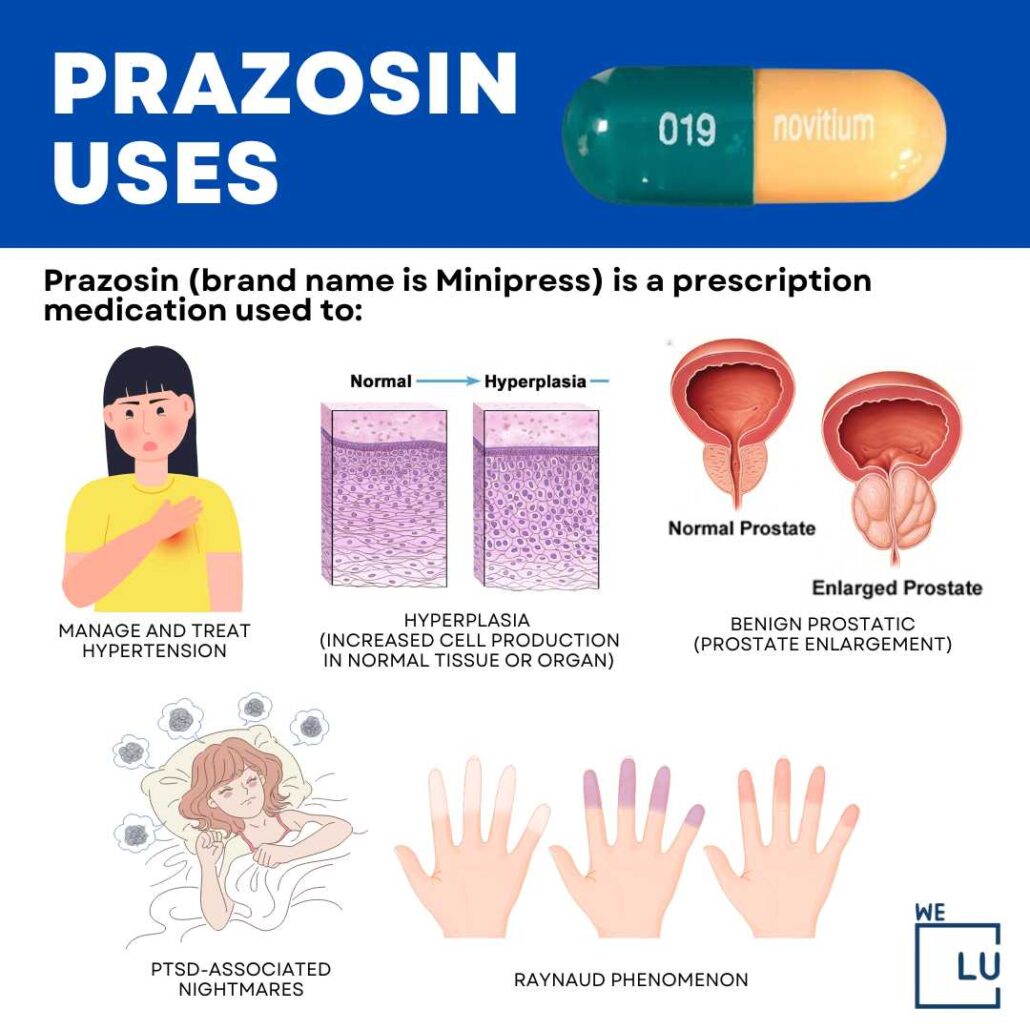Prazosin Powder, a medication commonly prescribed for high blood pressure and symptoms of benign prostatic hyperplasia (BPH), has been known to cause side effects in some patients. One of the most frequently reported side effects is dizziness or lightheadedness. This article will explore the relationship between Prazosin powder and these symptoms, as well as provide insights into managing and preventing them.
How does Prazosin work to lower blood pressure?
Prazosin Powder belongs to a class of medications called alpha-blockers. Its primary mechanism of action involves blocking alpha-1 adrenergic receptors in blood vessels, which leads to vasodilation (widening of blood vessels). This effect helps to reduce blood pressure by decreasing the resistance in the peripheral blood vessels.
When Prazosin is administered, it selectively binds to and blocks alpha-1 receptors in the smooth muscle of blood vessels. This blockade prevents the natural hormone norepinephrine from activating these receptors, which would otherwise cause blood vessels to constrict. By inhibiting this process, Prazosin allows blood vessels to relax and widen, resulting in improved blood flow and reduced blood pressure.

The vasodilatory effect of Prazosin is particularly beneficial for patients with hypertension, as it helps to lower both systolic and diastolic blood pressure. This reduction in blood pressure can significantly decrease the risk of cardiovascular complications associated with hypertension, such as heart attacks and strokes.
In addition to its effects on blood vessels, Prazosin also has a mild impact on the heart. By reducing peripheral vascular resistance, it can lead to a slight decrease in cardiac afterload, which is the pressure that the heart must overcome to eject blood into the systemic circulation. This reduction in afterload can result in improved cardiac function and efficiency.
It's important to note that while Prazosin is effective in lowering blood pressure, its effects are most pronounced when the patient is in an upright position. This positional dependency is due to the drug's impact on the body's ability to regulate blood pressure during changes in posture, which can contribute to the occurrence of dizziness or lightheadedness, especially when standing up quickly.
Can Prazosin cause orthostatic hypotension?
Orthostatic hypotension, also known as postural hypotension, is a condition characterized by a sudden drop in blood pressure when a person stands up from a sitting or lying position. Prazosin Powder has been associated with an increased risk of orthostatic hypotension, particularly during the initial stages of treatment or when the dosage is increased.
The mechanism behind Prazosin-induced orthostatic hypotension is closely related to its primary mode of action. As an alpha-1 adrenergic receptor blocker, Prazosin interferes with the body's natural ability to quickly adjust blood pressure in response to positional changes. When a person stands up, the body normally compensates for the gravitational pull on blood by constricting blood vessels and increasing heart rate. However, Prazosin's vasodilatory effects can impair this compensatory mechanism, leading to a temporary drop in blood pressure.
Orthostatic hypotension can manifest as dizziness, lightheadedness, blurred vision, or even fainting (syncope) when standing up. These symptoms typically occur within a few minutes of changing position and can be particularly pronounced in the morning or after prolonged periods of sitting or lying down.
Several factors can increase the risk of experiencing orthostatic hypotension while taking Prazosin:
- Age: Older adults are more susceptible to orthostatic hypotension due to age-related changes in blood pressure regulation.
- Dehydration: Inadequate fluid intake can exacerbate the blood pressure-lowering effects of Prazosin.
- Concurrent medications: Other drugs that affect blood pressure or cause dizziness can interact with Prazosin and increase the risk of orthostatic hypotension.
- Dosage: Higher doses of Prazosin are more likely to cause significant drops in blood pressure.
- Individual sensitivity: Some people may be more sensitive to the effects of Prazosin and experience more pronounced orthostatic hypotension.
To minimize the risk of orthostatic hypotension, healthcare providers often recommend starting with a low dose of Prazosin and gradually increasing it as needed. Patients are also advised to change positions slowly, especially when getting out of bed in the morning or standing up after prolonged sitting. In some cases, compression stockings or lifestyle modifications, such as increasing fluid and salt intake, may be recommended to help manage orthostatic hypotension.
It's crucial for patients taking Prazosin to be aware of the potential for orthostatic hypotension and to report any symptoms to their healthcare provider. In most cases, the body adapts to the medication over time, and the risk of orthostatic hypotension decreases. However, some patients may require dose adjustments or alternative treatments if orthostatic hypotension persists or significantly impacts their quality of life.
What are the best practices for taking Prazosin to minimize side effects?
When taking Prazosin Powder, it's essential to follow best practices to minimize potential side effects, including dizziness and lightheadedness. Here are some key strategies and recommendations for patients prescribed Prazosin:

- Start with a low dose: Healthcare providers typically initiate Prazosin treatment with a low dose, often 1 mg at bedtime. This approach allows the body to adjust gradually to the medication's effects, reducing the likelihood of severe side effects.
- Take the medication at bedtime: Taking Prazosin at night, just before going to bed, can help minimize the impact of potential dizziness or lightheadedness. This timing allows the body to adapt to the medication's effects while the patient is lying down.
- Gradual dose increases: If a higher dose is necessary, it should be increased gradually under the guidance of a healthcare provider. This slow titration helps the body adjust to the medication over time, potentially reducing the intensity of side effects.
- Stay hydrated: Maintaining proper hydration is crucial when taking Prazosin. Adequate fluid intake can help prevent dehydration, which can exacerbate dizziness and lightheadedness.
- Avoid rapid position changes: Patients should be cautious when changing positions, especially when getting up from a lying or sitting position. It's recommended to sit on the edge of the bed for a few minutes before standing up, and to rise slowly to allow the body to adjust to the new position.
- Be aware of alcohol and other medications: Alcohol and certain medications can interact with Prazosin, potentially increasing the risk of dizziness and lightheadedness. Patients should consult their healthcare provider about potential interactions and exercise caution when consuming alcohol.
- Monitor blood pressure: Regular blood pressure monitoring can help patients and healthcare providers assess the medication's effectiveness and identify any concerning drops in blood pressure that may lead to dizziness or lightheadedness.
- Maintain a consistent schedule: Taking Prazosin at the same time each day can help maintain steady blood levels of the medication, potentially reducing fluctuations that could lead to side effects.
- Be prepared for the first dose: The first dose of Prazosin is often associated with a higher risk of dizziness or fainting. Patients should take the initial dose in a safe environment, preferably when they can remain lying down for several hours afterward.
- Report side effects: Patients should keep their healthcare provider informed about any side effects experienced, including dizziness or lightheadedness. This information can help guide adjustments to the treatment plan if necessary.
- Consider lifestyle modifications: In some cases, healthcare providers may recommend lifestyle changes to complement Prazosin treatment and minimize side effects. These may include dietary adjustments, increased physical activity, or stress reduction techniques.
- Use supportive measures: For patients experiencing persistent orthostatic hypotension, healthcare providers might suggest using compression stockings or increasing salt intake (if appropriate) to help maintain blood pressure when standing.
- Be patient: It's important to note that the body often adapts to Prazosin over time. Side effects like dizziness and lightheadedness may diminish as treatment continues, so patience and consistent communication with healthcare providers are key.
By following these best practices, patients can optimize their Prazosin Powder treatment while minimizing the risk and impact of side effects such as dizziness and lightheadedness. It's crucial to work closely with healthcare providers throughout the treatment process, as they can provide personalized advice and adjustments based on individual responses to the medication.
If you are also interested in this product and want to know more product details, or want to know about other related products, please feel free to contact sasha_slsbio@aliyun.com.
References
- Mayo Clinic. (2022). Prazosin (Oral Route).
- MedlinePlus. (2022). Prazosin.
- American Heart Association. (2021). Types of Blood Pressure Medications.
- Harvard Health Publishing. (2020). Drug interactions with Prazosin.
- National Institute for Health and Care Excellence. (2019). Hypertension in adults: diagnosis and management.
- American Urological Association. (2021). Benign Prostatic Hyperplasia: Surgical Management of Benign Prostatic Hyperplasia/Lower Urinary Tract Symptoms.
- Journal of Clinical Hypertension. (2018). Orthostatic Hypotension: Mechanisms, Causes, Management, and Emerging Potential Therapies.
- British Journal of Clinical Pharmacology. (2017). Prazosin for treatment of nightmares in posttraumatic stress disorder: a systematic review and meta-analysis.
- Pharmacotherapy. (2016). Prazosin for the treatment of nightmares related to posttraumatic stress disorder: a review of the literature.
- European Heart Journal. (2018). 2018 ESC/ESH Guidelines for the management of arterial hypertension.

